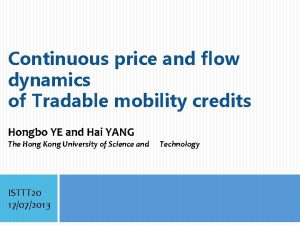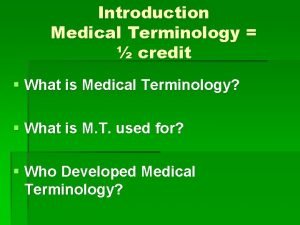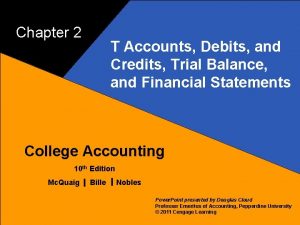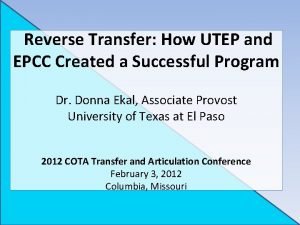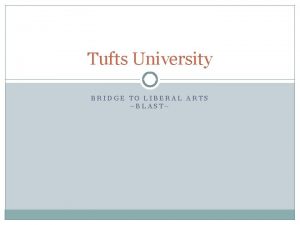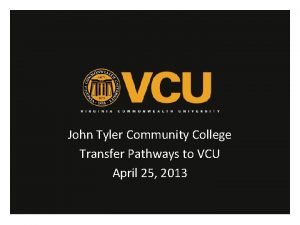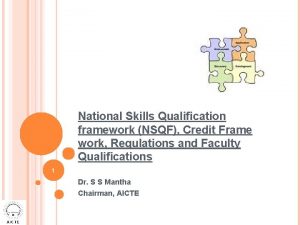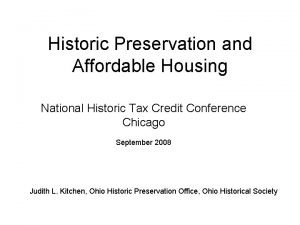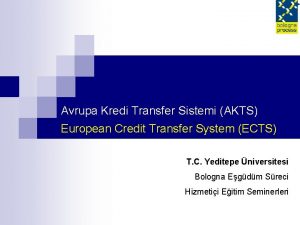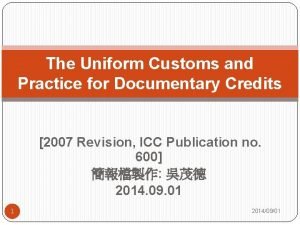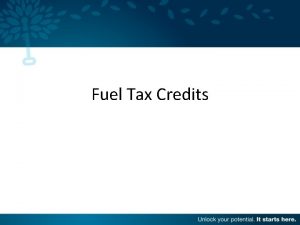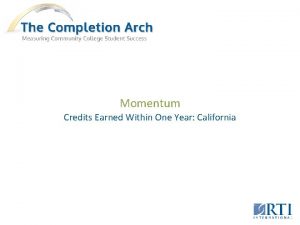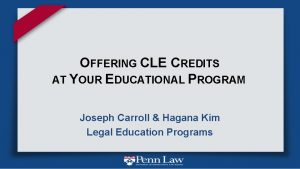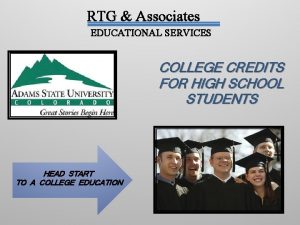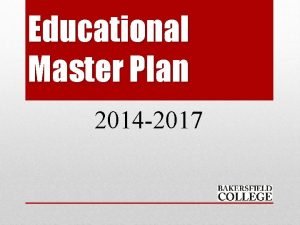Educational Credits Educational Credits Educational credits are credits
















- Slides: 16

Educational Credits

Educational Credits • Educational credits are credits to the taxpayer for qualified tuition and related expenses incurred by the taxpayer, spouse, or dependent who attend an eligible post secondary educational institute. The taxpayer must claim the dependent in order to qualify for the credit. • Eligible institutions include: colleges, universities, vocational schools, or community colleges. To check if an institution is eligible visit http: //ope. ed. gov/accreditation. • Qualified tuition and related expenses do not include: insurance, medical expenses, room and board, and transportation.

Educational Credits • There are two educational credits: – American opportunity Credit – The Lifetime Learning Credit.

Disqualifications for the credit: • Can be claimed as a dependent on someone else’s tax return. • Files MFS • AGI is above the limit for the taxpayer’s filing status • Taxpayer or spouse was a non-resident for any part of the tax year.

American opportunity Credit • Eligibility: – Enrolled in 2011 in a program that leads to a degree, certificate or other recognized educational credential – Taking at least one-half of the normal full-time workload for the course of study for at least one academic period beginning during the tax year – Enrolled in the tax year as a student in the first four years of postsecondary study – Free of any felony conviction for possessing or distributing a controlled substance – Only for the first for year of your first degree.

American opportunity Credit • 40% of the credit is refundable. That is up to $1000 is refundable. • Qualified tuition and related expenses includes expenditures for course materials such as books, computer, calculators, and ect. • The credit is up to $2500. The first $2000 is at 100% and the next $2000 is at 25%. Therefore, qualify for the full credit amount the educational expense should be $4000 or more. • Only for the first four years of post-secondary education

Lifetime Learning Credit • • Non refundable credit Only qualified tuition and related expenses Up to $2000. 20% of the first $10, 000 Not required: – Degree program – At least half full-time student – Free of drug convictions • No limit to the years it can be used

Qualified Education Expenses • For purposes of the lifetime learning credit, qualified education expenses are tuition and certain related expenses required for enrollment in a course at an eligible educational institution. The course must be either part of a postsecondary degree program or taken by the student to acquire or improve job skills. • Eligible educational institution. An eligible educational institution is any college, university, vocational school, or other postsecondary educational institution eligible to participate in a student aid program administered by the U. S. Department of Education. It includes virtually all accredited public, nonprofit, and proprietary (privately owned profit-making) postsecondary institutions. The educational institution should be able to tell you if it is an eligible educational institution

Credit reduced • Qualified expenses must be reduced by the amount of any tax-free educational assistance such as: – Pell grants – Employer provided educational assistance – Veteran’s educational assistance – Tax free portions of scholarships/fellowships – Refunds on qualified expenses such as a class that was drop and the cost refunded.

1098 -T

1098 -T • Box 1 and 2 reports educational expenses. Box five reports educational assistance. If box 2 and 5 have figures subtract box 5 from box 2, this equals the education expenses incurred in the year. If Box 5 is greater than Box 2 there is no educational credit and the remainder is assumed to be used on educational expenses, thus no income should be reported. Students can generally access their 1098 T through the institutions website, for instance GET. Always enter the full educational expense on the software it will automatically calculate the credit depending on which credit is applied. • Box 5 -Box 2= Educational expense on 1098 T

DOUBLE BENEFIT • There is no DOUBLE BENEFIT. That is you cannot claim both American Opportunity Credit and Lifetime Learning Credit.

Out of VITA Scope • Repayment of educational credits

Test your knowledge • James graduated in 2011 with a degree in accounting. He took the CPA review exam for the cost $3, 000. What credit does James Qualify for and what amount is the credit. • A) Lifetime learning for $600 • B) American Opportunity for $2, 250 • C) He can only itemize the educational expense • D) Does not qualify for educational expense

Test your knowledge • Scenario: Amanda is attending CSULA as a full-time student (Super Senior). Her mother, Jen, paid $6700 during the year for her education. Jen claimed the American opportunity credit in the year 2009 -2012. Which of the following statements is correct for the 2013 tax year: • A) Jen is eligible for the American Opportunity Credit • B) Jen is not eligible to claim an education credit but can use an itemized deduction • C) Jen is out of VITA Scope • D) Jen can use the Life Time Learning Credit

Test your knowledge • Scenario: George is 39 years old and is attending CSULA for his MBA. His son, James 18 years old, is also attends CSULA as a freshman seeking a BBA. Which of the following is statements is the most correct? • A) George can claim the American Opportunity Credit for his son and himself. • B) George can claim the Lifetime Learning Credit for himself and the American Opportunity Credit for his son. • C) George can only claim one credit because of the no double benefit rule • D) George can only claim the a lifetime learning credit for his son
 Insidan region jh
Insidan region jh Mobility credits
Mobility credits Credits medical definition
Credits medical definition Footings in t accounts
Footings in t accounts Mfda ce credits
Mfda ce credits Utep academic advising center
Utep academic advising center Michigan historic preservation tax credit
Michigan historic preservation tax credit Combining new markets and historic tax credits
Combining new markets and historic tax credits Blast tufts
Blast tufts New market tax credits st louis
New market tax credits st louis Vcu transfer requirements
Vcu transfer requirements Jamestown clip art
Jamestown clip art Credit frame
Credit frame The plaza apartments toledo ohio
The plaza apartments toledo ohio Ects credits nedir
Ects credits nedir The walking dead opening credits
The walking dead opening credits The uniform customs and practice for documentary credits
The uniform customs and practice for documentary credits

